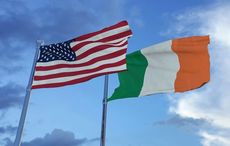Irish nationalist Martin Hogan, a member of the Irish Republican Brotherhood (IRB), was one of the many Irish Fenians banished to Australia for playing his part in the struggle for Irish independence.
Unlike the tens of others shipped off to foreign shores, however, it required a daring escape to bring Hogan to the US, where he is now laid to rest, widely forgotten, in an unmarked Chicago grave.
A group of historians in the city is currently attempting to erect a gravestone for Hogan, to keep the memory of his remarkable journey alive, with plans in place to unveil the gravestone at the cemetery this October 10.
Hogan was a member of the Fremantle Six, a half dozen Irish prisoners rescued from British captivity in Fremantle Prison, Australia – one of the most remote and impenetrable prison fortresses ever built – by a whaling ship that traveled from America with a heavily armed crew to rescue them.
"One of his letters talks about being forgotten, and this is about as forgotten as you can get," historian Niall Fennessy told DNAinfo.com. Fennessy is among the group fighting to keep the memory of Hogan and his fellow escapees alive. So far they have raised $4,000 towards erecting a headstone in his honor.
Born in Limerick in 1822, Hogan worked as a carriage painter before enlisting in the British Army. It is rumored that such was the strength displayed by Hogan as a soldier that he could break an iron bar in two with his sword.
Despite fighting for the British, Hogan was a member of the Irish Republican Brotherhood, a secret organization dedicated to establishing an independent Irish Republic. The IRB also had an American counterpart, known as the Fenian Brotherhood, run by John O'Mahony.
Many IRB members joined the British Army to acquire the military skills required of them to win Irish independence. By 1866, the IRB boasted of 80,000 members throughout Ireland and 15,000 members within the British Army. It is also believed that as much as a quarter of the Irish soldiers who fought for both the Confederate and Union armies during the American Civil War were Fenians.
When it became too difficult to maintain his double life as an IRB member and a British soldier, Hogan deserted the Army in November 1865 and hid in safe Fenian houses in Dublin working for the IRB.
In 1866, Hogan was chosen to be a part of special cavalry unit in a proposed IRB rising. Informer Patrick Foley, however, scuppered the IRB plans and the British Army began to arrest Fenians on a daily basis.
Hogan was arrested, along with fellow cavalry unit member James Wilson, on February 10, 1866. He was initially sentenced to death, but this was changed to life imprisonment and Hogan was shipped off across the Irish Sea to spend time in various English prisons.
On October 15, 1867, Hogan was among 279 prisoners (including 62 Fenians) who were roughly awakened in Portland Prison in England and told that they were to be transported to Australia. Little did Hogan know when abruptly awoken from his sleep that he was being transported to the place from which he – along with fellow Fenian prisoners James Wilson, Thomas Hassett, Thomas Darragh, Michael Harrington and Robert Cranston – would make prison escape history.
The prisoners were sent to Fremantle Prison (notoriously known as “the Establishment”), the highest security prison in the colonies. It was surrounded on one side by shark-infested waters and on the other by endless miles of unforgiving desert and rock.
The Fenian prisoners tried and failed for many years to get in contact with other members of the IRB, until Wilson succeeded in sending a letter to John Devoy, an IRB exile living in the US.
Joined by former Australian prison escapee and editor of the Catholic newspaper John Boyle O’Reilly, Devoy hatched a plan to penetrate the infamous Fremantle Prison bringing the Fenian prisoners to the US.
With the help of Clan na nGael (formerly the Fenian Brotherhood, the US branch of the IRB), they hired a whaling vessel, the Catalpa, to take them to Australia. The whaling vessel guise proved a perfect cover for their main intent. Not only could the escape plan be covered up by this fully functional whaling crew and ship, but a genuine whaling expedition would cover the costs of their escape plot and maybe even bring in a profit.
Traveling to Australia, the vessel reached the prison and strategically stationed itself in international waters sending a small whaling boat to the shore. On April 17, 1876, the Fremantle Six were rescued and embarked on the four month voyage back to the US.
Hogan arrived in New York on August 23, 1876 to a heroes welcome from fellow Irish in the city. As one of the Fremantle escapees, he traveled across the US giving speeches, finally settling in Chicago, where he married an Irish woman named Elizabeth and had two daughters – Ellen and Lillian.
Hogan died in Chicago in 1901 and his fascinating life story was forgotten, even by his own family. Chicago historians have attempted to contact the family to inform them of their commemoration plans. Speaking to Hogan’s grandson, Fennessy discovered that he had no idea of his grandfather’s life before he came to America.
The unveiling of the gravestone will take place in October 10 at the unmarked plot in Mount Olivet Cemetery.




Comments